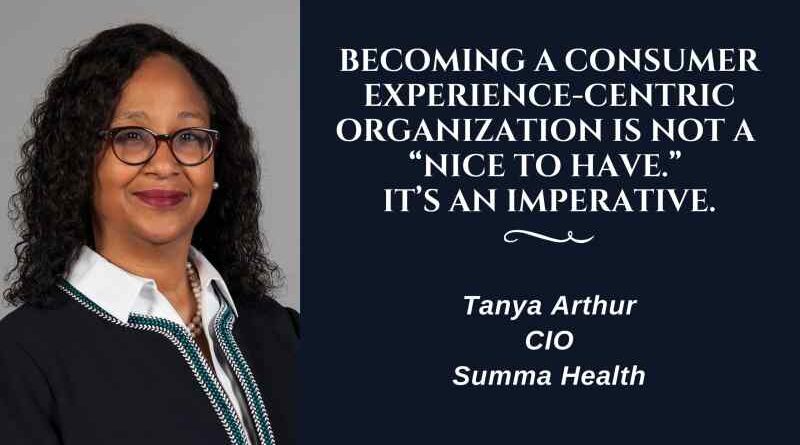Elevating the Consumer Experience in Healthcare
By Tanya Arthur, CIO, Summa Health
Over the years, the healthcare industry has been on an elusive journey to capture the hearts and minds of our patients. In the early to mid-2000s, patient-centered care and engagement programs became a pervasive part of the healthcare landscape. Service excellence discussions filled the airwaves of executive boardrooms. Some may even recall when healthcare systems across the country were asking themselves about the “9 1/2 things they would do differently if Disney ran their hospitals.”
So why has the healthcare industry struggled to leverage these opportunities to drive improvements in patient engagement, loyalty, and retention?
As it turned out, healthcare is not Disneyland… it is an incredibly complex, highly regulated, and slow-moving ecosystem. The fragmentation and deeply ingrained provider-centric cultures inherit in U.S. healthcare systems hamper engagement, waste both time and money and result in lower positive health outcomes.
Today’s healthcare consumers want a personalized, frictionless system of care – one that delivers clear value (cost/quality) and an exceptional experience, at least on par with what they experience in other industries.
Jeff Dachis, CEO One Drop, a diabetes management company, captured what many health consumers feel as they struggle to find solutions to better health, “The system is so fragmented. It is a burden on patients and it is incredibly disempowering.”
To thrive in today’s competitive landscape, health systems must think differently about the people they serve. We must see people as healthcare consumers and partners rather than “patients,” a term which is (not by accident) associated with
1) a person receiving medical treatment and
2) a state of being able to accept or tolerate delays, problems, or suffering without becoming annoyed.
Today’s healthcare consumers want a personalized, frictionless system of care – one that delivers clear value (cost/quality) and an exceptional experience, at least on par with what they experience in other industries.
PwC reports that 79% of customers rate customer experience as the most important component of the purchasing decision after product quality and price.
A recent Hospital Consumer Assessment of Healthcare Providers and Systems (HCAHPS) Star Rating report (used to collect and measure patient experience) shows that nearly 70 percent of the hospitals scored at or below the program average– highlighting both the opportunity for improvement and differentiation.
While HCAHPS remains an important part of consumer experience today, many of the survey questions were developed over a decade ago, casting doubt on whether it can still provide the level of insight needed to understand today’s consumers in ways that drive retention and increase market share.
Embracing healthcare customer experience is a tremendous opportunity for healthcare organizations to differentiate themselves, improve retention and increase revenue, yet few organizations have programs in place to understand their customers’ journey and align people, processes, and technology to create the kind of experience that our consumers want and need.
Prophet (a brand consulting firm) found that 81 percent of consumers are dissatisfied with their healthcare experiences. Whether it’s long wait times, inability to access care, high costs, regurgitating the same information again and again or poor handoffs resulting in miscommunications and delays in care— healthcare consumers are not happy consumers.
Consumers are more knowledgeable and have more choices on where to spend their time and hard-earned healthcare dollar.
What should today’s health systems do differently?
Understand that customer experience extends across every department in an organization and includes every consumer interaction extending from their first Google search through their entire care journey.
Remake departments and break down silos to remove friction from the consumer experience.
- As the old saying goes: “Form follows function.”– If your organization wants to deliver an exceptional customer experience, it must be intentional about the design of those experiences. Amazon, Zappos, Disney, and Apple— all leaders in consumer experience — did not get there by accident. Know your consumers’ journey, their preferences and pain points, and then redesign process, workflows, and technology to create consistently seamless experiences – placing the consumer first every time.
- Be obsessed with micro measurement. Develop an obsession for aligning internal and external processes across every consumer touchpoint. Gather insights from your data- and measure, measure, measure the small but important stuff… how is your organization increasing convenience and saving healthcare consumers time and money, every day, every time at every interaction? Establish systems and metrics that drive change.
- Establish a culture that lives by the “golden rule”– treat people like you would like to be treated. Keep it simple, but guide consumers through any unavoidable complexities in the system.
- Be relentless in designing digital, interoperable technology solutions – connect all consumer touchpoints. When systems are unable to “talk” to each other, the flow of information across various care settings is constricted. This results in errors, delays, and frustration among both patients and providers. Organizations must:
- Make interoperability a top priority when selecting systems;
- Standardize and simplify the number of applications required to deliver care across the care continuum; and
- Be able to quickly and cost-effectively connect disparate systems by investing in robust data integration engine capabilities such as Fast Healthcare interoperability resources (FHIR) and open Application Programming Interfaces (APIs).
While healthcare is unique in its complexity and unrelenting government and regulatory pressures, consumers have more choices and are demanding more than ever before. Becoming a consumer experience-centric organization is not a “nice to have.” It’s an imperative.



